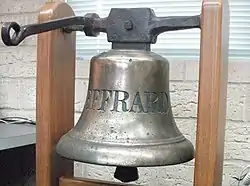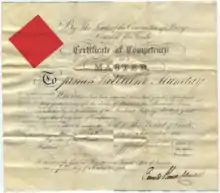 The bell of Geffrard, hanging in Bussleton Primary School | |
| History | |
|---|---|
| Australia | |
| Name | Geffrard |
| Builder | Fred Clark[1] |
| Completed | 1853 |
| Identification | 23262 (Official number)[2] |
| Fate | Wrecked, 13 June 1875, Western Australia |
| General characteristics | |
| Class and type | Brig |
| Tons burthen | 316.13 long tons (321.20 t) |
| Length | 37 m (121 ft)[3] |
| Notes | Composite construction (wood and iron)[4] |
Geffrard was a 321-ton British brig[2] that traded between Australia, Mauritius, and Shanghai,[5] and was wrecked off the coast of Western Australia on 13 June 1875.[2] She was built in 1853 by Fred Clark in Jersey in the Channel Islands.[1] By 1873 she had made her way to Melbourne and was owned by Fred Davis[1] and under the control of Captain William James Munday.[6] Her movements after that were generally around the southern coasts of Australia, from Geraldton in the west to Sydney in the east, laden with a variety of general cargo.[7][lower-alpha 1][15][16]
On 21 May 1875 she was loading timber at Quindalup, bound for Adelaide.[17] This voyage was completed without event, and she returned to Fremantle; but three weeks later, bound on the same journey, mooring in the same place led to disaster.
Grounding and wrecking
On 12 July the Geffrard took on board a load of timber,[2] and after stowing this cargo Captain Munday went ashore (at about 6pm) to conclude business with Henry Yelverton.[2] He had put down a single large anchor, as was usual for a brig of that type, and was confident that this would hold through the coming storm.[2] However, due to a faulty weld in the chain, the chain parted and the ship went aground on a sand bank. By the morning, she was breaking up and nothing could be done to save her.[2]
Munday was charged with negligence, but exonerated by an inquiry conducted by the Collector of Customs at Bussleton.[2]
The salvaged materials from the wreck were auctioned by the Manning company in Fremantle, six months after the grounding.[18] All fittings were bought by Yelverton, who installed the ship's bell outside his office at Quindalup beach.[19][20]

Munday died in November[21] of the same year, in Melbourne[22] and after a prolonged illness. A memorial to him and his wife still stands in the Busselton Pioneer Cemetery, not far from Yelverton's.
The spot where the ship went aground was still known as the Geffrard Bank in the late 1940s.[19]
Ship's bell
After being salvaged, the ship's bell was placed at Henry Yelverton's house office, where it was used for many years to mark the start and end of the working day.[19] According to his grandson H.G. Yelverton, after Yelverton's death his son gave the bell to G. B. Milne, the headmaster of the Busselton school, for installation at the school.[19]
Rediscovery of the wreck
In 2009 and 2011 archeological surveys were undertaken by the WA Museum, and what were almost certainly the remains of the Geffrard were discovered and documented.[4]
The first survey was conducted as part of the 2009 WA Museum Australian Leadership Awards Fellowship (ALAF) Placement, and led by Wendy van Duivenvoorde. Three other vessels wrecked in the area and were of interest during this survey: Governor Endicott in 1840; Halcyon in 1845; and Ella Gladston in 1878 (refloated).
The primary locating documentation was W. E. Archdeacon's map of 1876.[23]
Notes
References
- 1 2 3 Henderson, Graeme; Henderson, Kandy-Jane (1980). Unfinished Voyages. University of Western Australia Press. OL 4731124W.
- 1 2 3 4 5 6 7 8 . Busselton, Western Australia: Court of Inquiry. 1875 – via Wikisource.
- ↑ Jennifer Rodrigues; Wendy van Duivenvoorde; Michael McCarthy; Michael Gregg (March 2011), "Australasia News, Western Australia" (PDF), Newsletter of the Australasian Institute for Maritime Archaeology, p. 13, archived from the original (PDF) on 20 March 2012,
The Geffrard remains, however, were located, with the wreck's location matching a position marked on contemporary charts. The wreckage includes iron knees and a keelson with copper alloy fastenings, indicating a vessel of the middle to late 19th century and not a whaler. The remains also fit the circumstances of the 37-m, 316-ton brig Geffrard, which ran ashore in a gale whilst loading timber. Of the shipwrecks known to lie in the region, only Geffrard was unresolved at the time of the expedition.
- 1 2 Green, Jeremy, The Busselton Area Survey 2009 and 2011 and the finding of the Geffrard (PDF), archived from the original (PDF) on 12 October 2013, retrieved 6 October 2013
- ↑ Deadman, Ron, Geographe Bay wrecks and shipping incidents (PDF), archived from the original (PDF) on 14 November 2013, retrieved 21 August 2012
- ↑ "Shipping Intelligence". The Perth Gazette and West Australian Times. 31 January 1873. p. 2. Retrieved 17 August 2012.
ARRIVAL. Jan. 24.-Geffrard, brig, 316 tons, W. J. Munday, from Melbourne, via Adelaide. Passengers — in cabin, Mr. and Mrs. F. Davis; T. & H. Carter & Co., agents.
- ↑ "Adelaide". The Sydney Morning Herald. 4 January 1873. p. 6. Retrieved 17 August 2012.
Nearly 4000 packages tea, ex Geffrard, [at] auction to-day at fair prices.
- ↑ "ENTERED OUTWARDS — October 1". Empire (Sydney). 2 October 1873. p. 2. Retrieved 17 August 2012.
Geffrard, brq, 316 tons, Munday, for Adelaide.
- ↑ "PROJECTED DEPARTURES — OCTOBER 7". The Sydney Morning Herald. 7 October 1873. p. 4. Retrieved 17 August 2012.
Geffrard, for Adelaide.
- ↑ "CLEARANCES. — October 6". Empire. 7 October 1873. p. 2. Retrieved 17 August 2012.
Geffrard, brig, 316 tons, Munday, for Adelaide.
- ↑ "PROJECTED DEPARTURES — OCTOBER 9". The Sydney Morning Herald. 9 October 1873. p. 4. Retrieved 17 August 2012.
"Geffrard, for Adelaide.
- ↑ "PROJECTED DEPARTURES — OCTOBER 10". The Sydney Morning Herald. 10 October 1873. p. 4. Retrieved 17 August 2012.
Geffrard, for Adelaide.
- ↑ "DEPARTURES — Ootober 11". Empire. 13 October 1873. p. 2. Retrieved 17 August 2012.
Geffrard, brig, for Adelaide.
- ↑ "ADELAIDE. Arrivals". The Sydney Morning Herald. 11 November 1873. p. 4. Retrieved 17 August 2012.
November 4.-Geffrard, from Newcastle.
- ↑ "CHAMPION BAY". The Perth Gazette and West Australian Times. 16 January 1874. p. 3. Retrieved 17 August 2012.
The 'Geffrard,' brig, arrived here on Sunday, from Fremantle, after a run of 24 hours from port to port.
- ↑ "PORT OF ADELAIDE". The Argus (Melbourne). 27 January 1875. p. 4. Retrieved 17 August 2012.
Jan 25—...Geffrard, from Western Australia.
- ↑ "VASSE". The Western Australian Times. 21 May 1875. p. 5. Retrieved 17 August 2012.
The Geffrard is loading at Quindalup, for Adelaide.
- ↑ "Classified Advertising". The Western Australian Times. 14 December 1877. p. 3. Retrieved 17 August 2012.
Sale by Auction. Tuesday next, 18th Dec., at South Jetty, Fremantle. A quantity of Gear, Copper Bolts, Iron Knees, Wire Rigging and Copper. Without any Reserve. L. A. Manning & Co. Have received instructions to sell, as above, at 12 o'clock, a quantity of Ship's Gear &c., belonging to the wreck of the "Geffrard," comprising-- Wire rigging, bolts, copper, lead pipe, &c., &c., &c. Terms at Time of Sale. Fremantle, Dec 12th 1877.
- 1 2 3 4 "Bell From Old Ship". The West Australian. 8 July 1949. p. 21. Retrieved 17 August 2012.
BUSSELTON, July 7: A letter received this week by the headmaster of the Busselton State School (Mr. S. G. Demasson) from Mr. H. G. Yelverton, of Quindalup, clears up the mystery as to how a bell from the Norwegian ship Geffrard came to be at the school. Mr. Yelverton said that the Geffrard was driven ashore about 1875 or 1876 while loading timber for Mauritius and became a total wreck. His grandfather, the late Mr. Henry Yelverton, bought all the fittings off the wreck, including the bell, which was placed outside his house office at the Quindalup beach, where it remained for a number of years and was rung to call the men to work and knock off. It was given by Mr. H. G. Yelverton's father, the late Mr. H. J. Yelverton, to the late Mr. G. B. Milne for erection at the Busselton school. While fishing over a bank about a quarter of a mile north-east of the old Quindalup jetty on a calm day between 1888 and 1900 Mr. W. J. Harwood could still see the remains of the wreck. This bank is still known to older residents of Quindalup as the Geffrard Bank.
- ↑ "MYSTERY OF SCHOOL BELL PARTLY SOLVED". Daily News (First ed.). Perth, Western Australia. 18 June 1949. p. 2. Retrieved 17 August 2012.
BUSSELTON, Sat: The mystery of Busselton school bell has been partly solved. The name on the bell is Geffrard. The bell is from a three-masted Norwegian schooner which used to load timber from Quindalup, about 11 miles south of Busselton. The Geffrard was beached on the east side of Quindalup jetty during a severe storm about 70 years ago. Mr. G. Harris, one of Quindalup's oldest residents — he is 79 — remembers that his brother Jack was in charge of the boats that used to take the timber to the ships because they were unable to tie up at the jetty. Headmaster S. G. Demasson still does not know the other half of the puzzle — how the bell came to the school.
- ↑ Death certificate of James William Munday, 11 November 1875
- ↑ "Family Notices". The Inquirer & Commercial News. Perth, WA: National Library of Australia. 22 December 1875. p. 2. Retrieved 2 March 2015.
- ↑ Archdeacon, W. E. (1876), Sheet 2 Australia—West Coast. Koombanah Bay to Cowaramup Point
33°37′51.031″S 115°9′31.752″E / 33.63084194°S 115.15882000°E